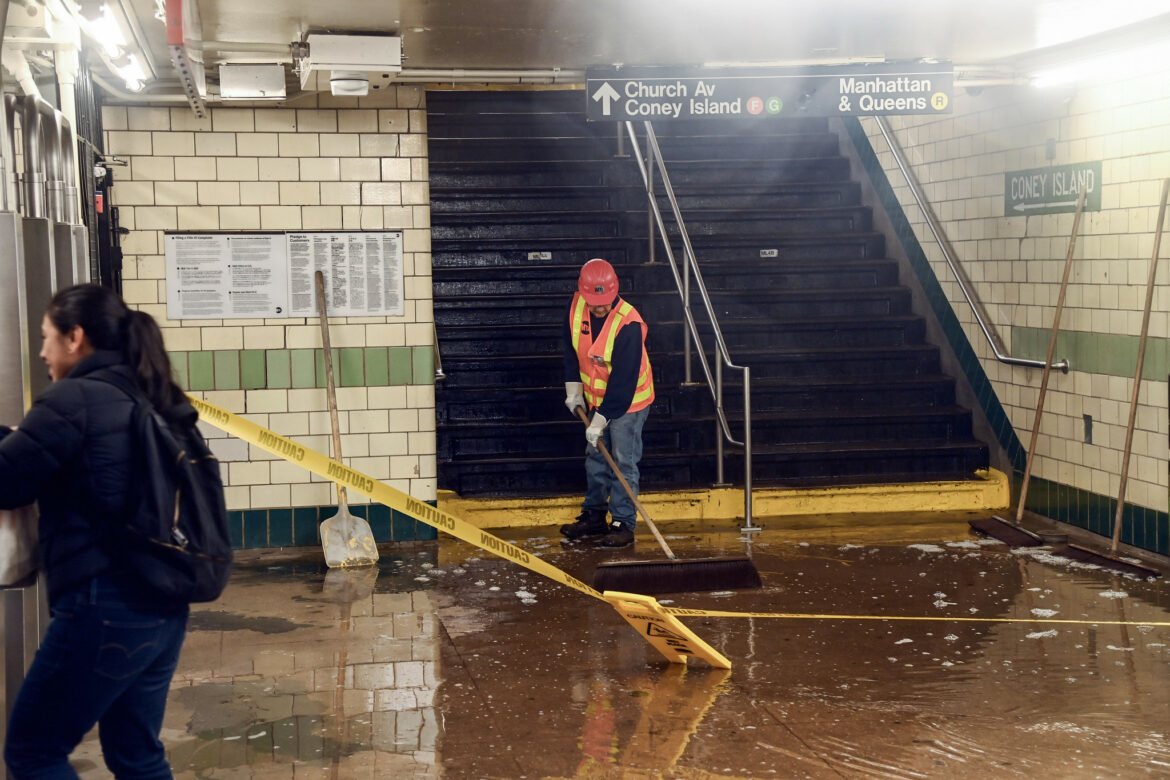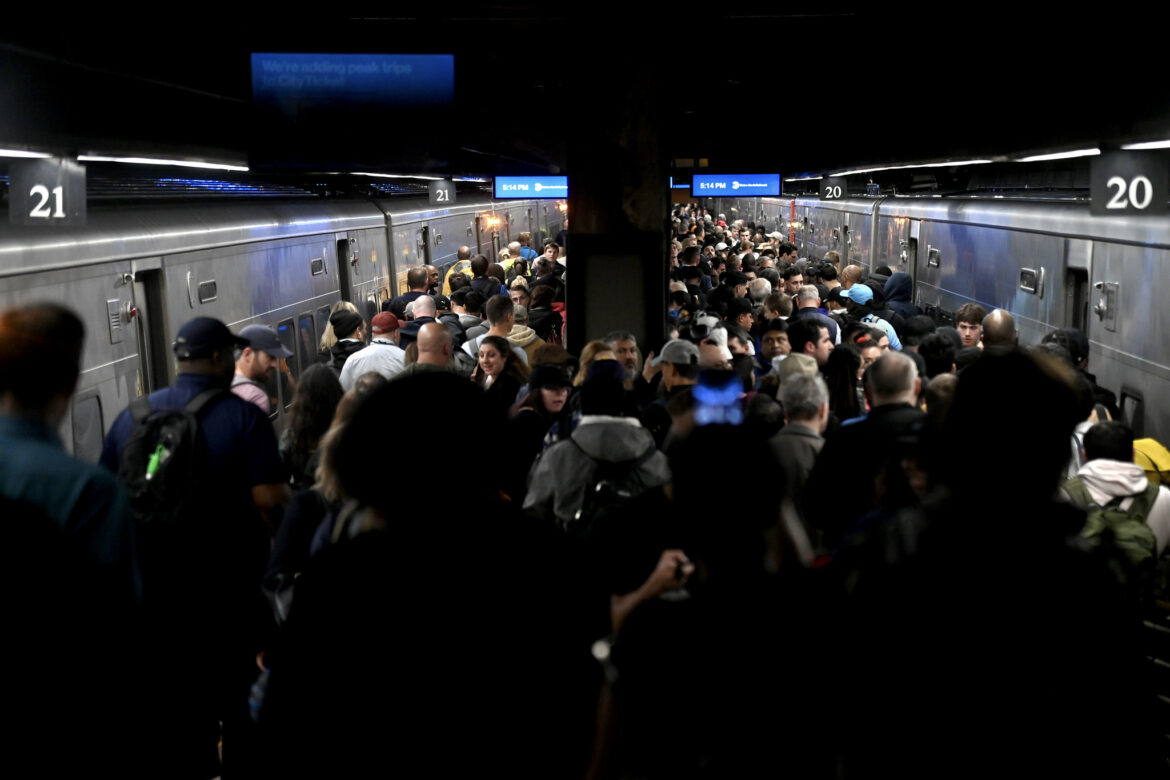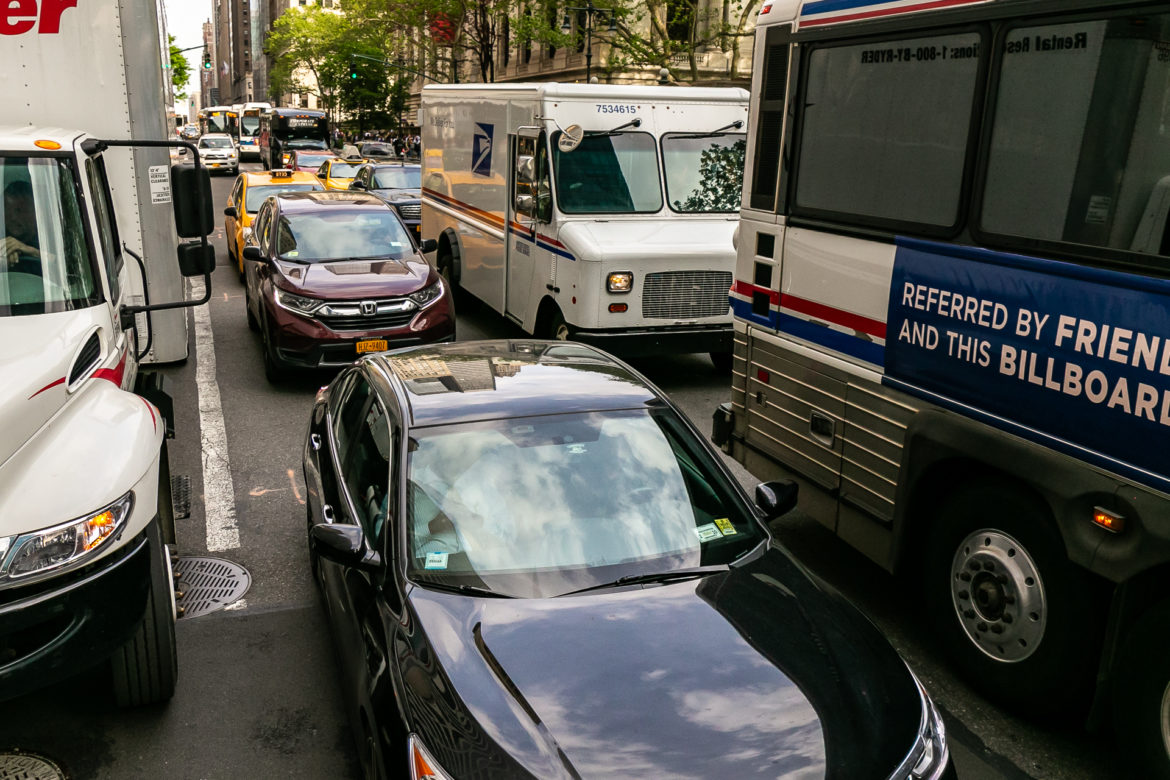The MTA says losing the revenue generated from congestion pricing could create a domino effect that impacts a series of climate resiliency projects, like fortifying the subway system from flooding and extreme heat.

Marc A. Hermann / MTA
A flooded Brooklyn subway station following heavy rains on Friday, Sep 29, 2023.New Yorkers who’ve seen the subway seriously flood on their way home after a storm might be wondering how Gov. Kathy Hochul’s decision to “indefinitely” pause congestion pricing will affect plans to protect the transit system from climate change.
The program sought to charge a toll to drivers entering Manhattan south of 60th Street, which would raise $15 billion for the Metropolitan Transportation Authority (MTA) to fund crucial improvements, from buying new subway cars to modernizing century-old subway lines.
In pausing the plan, Hochul cited concerns over the burden that paying $15 to enter Manhattan would cause many residents.
But losing that revenue will directly impact the transit system’s ability to withstand the catastrophic effects of global warming like flooding and extreme heat, warns Andrew Darrell, New York regional director at the Environmental Defense Fund (EDF).
“Any delay in investments that keep the [transit] system from operating at its best will mean that the system won’t operate as well during a severe weather crisis,” Darrell said.
At a board meeting last month, MTA officials revealed that $16.5 billion worth of projects set to start at the end of 2024 will now get pushed back. They will be included instead in the next round of planned expenses known as the Capital Plan, which spans from 2025 to 2029 and will be released in the fall.
While climate change resiliency projects are not among those getting delayed, MTA officials warn that the deferral of other upgrades could create a domino effect, impacting the ability to fund other initiatives down the line.
“This unavailability of funds that we are experiencing could have a very significant impact on the 2025 to 2029 [budget cycle] itself,” Tim Mulligan, deputy chief development officer at the MTA, said at the board meeting.
With resources being scarce, the agency must prioritize more basic needs over projects aimed at fortifying the system against global warming, an MTA spokesperson also told City Limits.
And losing funding for resiliency efforts may not be the only environmental loss: nixing the congestion pricing program means more cars will remain on the road, generating pollution. The transportation sector is responsible for nearly 28 percent of New York’s greenhouse gas emissions.
While congestion pricing opponents have pointed to potential increased air pollution in the South Bronx as drivers attempt to circumvent the tolls, other environmental groups say the program would bring universal benefits that far outweigh potential blows.
“If you believe that our public transportation system is the life-blood of our healthy economy in this region, and if you believe that we have to find a way to chip away at the impacts of climate change, then you should understand that losing this program is a loss for everyone,” said Tiffany-Ann Taylor, vice president for transportation at the non-profit Regional Plan Association (RPA).
Billions in deferrals
When Hochul put the congestion program on pause, she reassured New Yorkers that her “commitment to a greener, more sustainable future is unwavering.” Resources would be “set aside” to “backstop the MTA Capital Plan,” she added, saying the administration is “currently exploring other funding sources,” to make up for the lost revenue.
“As the Governor has made clear, she is committed to funding the MTA Capital Plan, and is working with partners in government on funding mechanisms for the MTA while congestion pricing is paused,” Hochul’s office told City Limits in a statement Thursday.
But axing the program, MTA officials said at their most recent board meeting, means delaying a series of crucial transit upgrades.
That includes $3 billion for key maintenance work and plans to renovate five subway stations that the MTA is yet to identify, and another $3 billion for modernizing 1930s-era signal systems in the subway that, like traffic lights, allow trains to come and go. The purchase of 437 new subway cars and commuter rail cars will also be delayed.
But what would that mean for the transit authority’s environmental projects?

Marc A. Hermann / MTA
Commuters crowd a platform at Grand Central Terminal in September, following record rainfall that disrupted subway and train lines.For one, the MTA will have to defer $500 million for the purchase of 250 electric buses, a move that could jeopardize the city’s ability to transition its bus fleet off polluting fossil fuels.
Environmentalists are also now wondering how it could affect the MTA’s plans to invest $6 billion over the next 10 years in making the transit system more resilient to climate change.
The investments would keep bus depots and railroad stations from flooding, and it would “shield subway stations and tunnels from stormwater,” according to the MTA’s Resilience Roadmap. The plans also aim to “expand underground air circulation and cooling” to protect commuters from extreme heat.
Addressing all of these issues could prove difficult if the MTA is unable to fund its most basic needs, officials warn.
At the board meeting on June 26, Mulligan said that even maintaining their infrastructure at a state of good repair will be hard, as the $12 billion that has been earmarked to tackle the most crucial projects “isn’t sufficient.”
Deferring the funds to the next capital budget will kick high-priority work down the road, Mulligan and his team fear.
“If the funds are deferred for a long period of time,” said Jamie Torres-Springer, the MTA’s president of Construction and Development, it will “just push out more of the critical work further.”
Environmentalists worry New York City’s transportation system is not ready to face climate change head on. In September, heavy rains brought much of the subway system to a standstill, and some 200 stations have flooded in recent storms, the MTA told NBC News in January.
“You have these multiple cascading impacts caused by climate change like raised temperatures, more severe storms, higher sea levels and more flooding. And it’s essential to the life of the city that our transportation system be modern and ready to face these challenges,” Darrell at EDF highlighted.
How good is the plan for the environment?
While creating a revenue stream that could help the transit system tackle climate change sounds like a great idea for some, congestion pricing opponents have argued that the program could actually be bad for the environment in some parts of the city.
Although the program is expected to improve air quality in three boroughs, it could also divert traffic to the South Bronx and increase air pollution in the area, according to the MTA’s Environmental Assessment of the program.
The assessment studied seven different ways in which congestion pricing could play out by switching up a series of variables, from pricing to how many times drivers are charged per trip. In every scenario, the South Bronx appears as a region that would face some kind of increase in air pollutants.
“As an already disproportionately pollution-burdened community, we simply can’t accommodate any more pollution,” said Arif Ullah, Executive Director of the environmental and social justice group South Bronx Unite.
The area has historically grappled with high rates of asthma thanks to concentrated pollution brought on by traffic congestion and industrial warehouses in the region.
To tackle the issue, government officials committed to diverting some of the toll money congestion pricing was expected to generate to renovating green spaces around the city, improving ventilation in schools and building an asthma center in the Bronx.
While experts say it shouldn’t take a congestion program to finally address the Bronx’s pollution woes, losing the funds will mean walking away from investments in these mitigation efforts.

Adi Talwar
Friday evening traffic heading West on 42nd Street between 5th and 6th Avenues in Manhattan.It also means losing other universal environmental gains: reducing the overall greenhouse gas emissions that drive climate change. The congestion toll would have encouraged drivers to swap their cars for public transit, leading to an estimated 17 percent fewer vehicles entering the congestion zone.
One study found that London’s congestion pricing program resulted in 13 percent fewer vehicles in the zone during peak hours, and climate change-inducing carbon dioxide emissions from transportation went down by 28 percent across London between 2010 and 2023.
“There are legitimate concerns about [traffic] diversions. But you also have to look at what the universal benefit is,” said Dr. Rachel Weinberger, director of research and strategy at RPA.
Not implementing the program at all, the MTA’s Environmental Assessment warns, will ultimately do more harm than good.
“As part of their analysis, they looked at a baseline scenario where no congestion pricing program would be implemented. And in that scenario, driving into Manhattan actually increased,” Louise Yeung, chief climate officer at the city’s comptroller’s office, told City Limits.
“So we’re looking at a scenario where if no action is taken, there will be more carbon emissions over time,” Yeung added.
To reach the reporter behind this story, contact Mariana@citylimits.flywheelstaging.com. To reach the editor, contact Jeanmarie@citylimits.flywheelstaging.com
Want to republish this story? Find City Limits’ reprint policy here.









2 thoughts on “What’s at Stake for the Environment in Hochul’s Decision to Halt Congestion Pricing”
The United States Department of Transportation Office of Inspector General announcement that they will initiate an audit of the Federal Transit Administrations unexpended Hurricane Sandy recovery, relief and resilency grant funds is disappointing news.
Three months from now — October 2024 will mark the 12th Anniversary for Hurricane Sandy.
Something is seriously wrong if according to the US DOT OIG, there is a balance of $3.8 billion in $10.9 billion previously approved funding in FTA obligated grant recipients for Hurricane Sandy recovery, relief and resiliency programs. How many of the $3.8 billion projects are still not under contract or not yet completed.
The first wave of recovery and relief grants were to fund activities and capital projects to restore assets and services adversely impacted by Sandy. Given the high priority of these projects, 100% of all work should have been completed and in beneficial use within three years, or the end of 2015.
The second wave of grants known as resiliency were desired to prepare for future natural disasters. How many major storms have come and gone resulting in service disruptions with the MTA subject to this audit over the past twelve years? Why wasn’t 100% of this grant funded work completed within the following three years or the end of 2018? How many times in recent years have major storms resulted in adverse impacts of transit agencies ability to maintain service? How many service disruptions could have been avoided if several billion in resiliency projects were completed and in beneficial use years ago?
The MTA may not be enough resources to integrate the implementation of all of the billions in annual FTA assistance including (1) formula Section 5307 Urbanized Area, Section 5337 State of Good Repair, Section 5309 Bus and Bus Facilities along with others; (2) Federal Highway Administration funding under several programs including Congestion Mitigation Air Quality (CMAQ), Surface Transportation Program (STP) that can be transferred to FTA); and (4) 100% locally funded capital projects along with (5) billions more in Hurricane Sandy Recovery and Resilience funding. The MTA with ongoing Hurricane Sandy funded capital projects may have lacked sufficient procurement, project managers, engineers, legal and force account employees, along with track outage availability (for those with subway or commuter rail) to proceed with all these projects in the same time frame.
In you own words you were ,”Founded in 1976 in the midst of New York’s fiscal crisis.” & ” City Limits uses investigative journalism” .
In Mariana Simoes article, What’s at Stake for the Environment in Hochul’s Decision to Halt Congestion Pricing, investigative journalism is abandoned in favor of a one sided ideology..
The MTA”s supposed concern for the environment, and its lack of money to finance repair and upgrade of its antiquated system, is absurd.
Multiple studies and true investigative journalism reveal the MTA as the most wasteful and inefficient transportation agency in the World.
See NYU Marron Institute of Urban Management, Transit Costs Project research also their summation of NYPost article titled, MTA SPENT TWICE AS MUCH ON SECOND AVE
Subway Consultants as It Did to Tunnel.
See also NY Times investigative jounalist, Brian Rosenthal’s article titled, The Most Expensive Mile of Subway Track on Earth.
The MTA’s lack of funds has NOTHING TO DO WITH UNDER FINANCING or Governor Hochul’s suspension of Congestive Pricing & EVERTHING TO DO WITH THE MTA’s EXCESSIVE WASTE & INEFFICIENCY.
Your publication, Founded in the Middle of the NYC financial crisis, should be acknowledging and emphasizing the MTA’s waste and inefficiency and calling for reform instead of supporting the MTA’s false and ridiculous climate excuses for its need to implement congestion pricing.
If the MTA and its advocates are so concerned about pollution then they should be adamant about NY subway station polluttion which is worse than above ground pollution.
See NYU Langone Health 2021 study titled.
“Pre–COVID-19 Subway Air Polluted from DC to Boston, But New York Region’s Is the Worst, Study Finds”
Also, Congestion Pricing if implemented would shift some pollution from the Central Business District to the FDR Drive, West Side Highway, The Batery Area and north to the Cross Bronx Expressway.
How does moving pollution to areas so close to the CBD solve or minimize pollution?
The problem is not Governor Hochul’s pause,
The problem is the MTA
Sincerely
James Chiofalo
President ACT
Member
Keep NYC Congestion Tax Free and
The Coalition in Opposition to Congestion Pricing